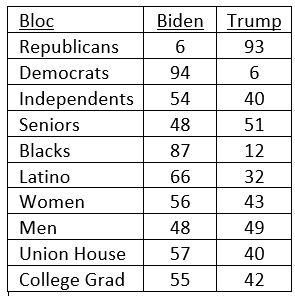
An Energized Electorate, No Tectonic Shifts
By Patrick Sprinkle
The 2020 presidential election, with the highest turnout (67%) since the 1900 Election, revealed a deeply divided electorate. By the time all the votes are counted, both President Donald J. Trump and Vice President Joe Biden will surpass Barack Obama’s 2008 total for most votes ever received by a presidential candidate. This reveals an energized and invigorated electorate engaged in the democratic process. And it reveals the collective success of our election bureaucracy during a global pandemic, using vote-by-mail and early voting.
The aim of this piece is to explore exit polls along the lines of gender, race, residence, and the interaction of education and race. While there were no major shifts in the electorate, small changes, especially among the suburban voters, proved critical to elevating Joe Biden to a national popular vote victory. The chief source here is the exit poll compiled by the National Election Pool, supported by a consortium of major news organizations with a sample size of 15,590. It should be noted that exit polls are an imperfect measure. This note should be amplified given the high number of voters who participated by mail. Yet, Edison Research has altered its methodology to try and account for and represent mail-in and early voters who were missed on election day.
Gender. While many political pundits expected a much larger gender gap compared to the 2016 election this does not appear to be the case. Joe Biden was able to improve over Hillary Clinton’s percentage amongst women by 2 points (54% for Clinton to 56% for Biden) and with men by 7 points (41% to 48%). The gender gap as measured by the support for the Democratic candidate narrowed by 5 points.
Race. One result that confounded the Biden campaign was that President Trump was able to increase his support among Black (8% to 12%) and Latinx voters (29% to 32%), while only losing 1% off of his 2016 totals amongst white voters (58% to 57%). It is essential to note that Latinx voters in the exit poll are not broken down by their ancestral nation. So Mexican-Americans likely have different voter preferences than Venezuelan-Americans and Cuban-Americans. For example, in South Florida President Trump narrowed the gap among Latinix voters in Miami-Dade County by 23 points compared to 2016 based largely on his strength with Cuban-Americans. Trump had a strong early outreach to the sub-group with anti-socialist rhetoric. This was not unique to Cuban-Americans as Trump was also able to perform stronger in Vietnamese-American communities in California with a similar approach.
The major shift was that Biden was able to secure a greater percentage of white voters than Hillary Clinton (37% to 42%) and these voters, it seems, either did not vote in 2016 or supported a third-party candidate.
Residence. This, in the final analysis, may be the most salient factor in understanding American politics. A great deal of ink will continue to be poured into the metro-rural divide in the United States. While Joe Biden was able to make inroads with rural voters over the Democratic nominee last time (34% to 45%), he was also able to increase his margin in urban areas with over 50,000 people, (59% to 60%). This massive division between metro and rural voters will be critical to understanding the temperament and mood of the electorate.
While these changes are along the margin and do not weigh as heavily on the national vote total, it was in the suburbs where Biden’s message was able to flip the most voters. A slim majority (51%) of voter across the country identify as living in the suburbs. Vice President Biden was able to win them more so than Hillary (45% to 51%). These margins will prove critical in the suburbs of Atlanta, Milwaukee, and Philadelphia, in the critical swing states of Georgia, Wisconsin, and Philadelphia as the votes are fully counted and the elections are officially certified.
Education and Race. Marginal changes in the electorate can flip a state and this is so evident in terms of race and education. Joe Biden tied President Trump at 49% each with whites with a college degree while he closed the margin with whites without a college degree, 28% for Clinton in 2016, 35% for Biden this time. Trump’s support amongst white college grads stayed the same for both of his elections, while Joe Biden increased on Hillary’s 2016 margin by 4%. This points to a trend previously considered: voters who did not participate or voted for a third-party candidate in 2016 moved towards the Vice President this time. This was confirmed in the national exit poll; Joe Biden won 62% of 2016’s third-party voters and 61% of 2016’s non-voters.
Simultaneously, the Democratic candidate shed nonwhite voters without a college degree compared to his 2016 predecessor (75% to 72%). Taken collectively, this explains how Joe Biden can lose voters as a percentage in Philadelphia compared to Hillary Clinton and still win the state overall.
Ultimately, elections are decided on the margins. Joe Biden’s national popular vote win can be attributed to improvements among suburban voters, voters who did not participate and those who cast third-party votes in 2016, and slight improvements among white voters, especially those with a college degree. In addition, Joe Biden was able to hold female voters and maintain the traditional gender gap between the parties and largely hold the vast majority of nonwhite voters while making increases with Asian voters.
Patrick Sprinkle is a high school American government and history teacher at the New York City Lab School for Collaborative Studies in Manhattan, New York.

